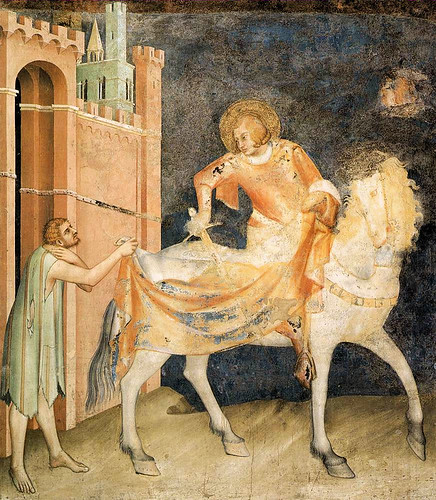It was while in Amiens that he experienced a vision that became a memorialized event in his life. He had met at the gates of the city of Amiens a scantily dressed beggar for whom Martin cut in half his military cloak to share it with the beggar. That night, he dreamed of Jesus wearing the half cloak that Martin had given away and heard Jesus telling the angels: "Here is Martin, the Roman soldier who was not baptized. He has clad me." Confirmed in his intent by this vision, Martin was baptized and after serving two more years left the army. He then traveled to Tours.
In 371, Martin was acclaimed bishop of Tours. As bishop of Tours he greatly impressed the city's inhabitants with his demeanor and zeal in destroying the pagan temples. Sulpicius Severus recorded in the Vita of St. Martin many of the events of this period. Sulpicius further recorded Martin's withdrawal from the tensions of the city to the monastery, Marmoutier, that he founded across the Loire river from Tours. Here Martin led a austere life among the cave-dwelling cenobites who had gathered around him.

After his death he was buried in Tours where, in time, a large basilica was built as the shrine of St. Martin of Tours. The basilica was built over his grave and was a major stopping point on pilgrimages during the middle ages. During the Wars of Religion in 1562, the Huguenots sacked the shrine and it was completely destroyed during the French Revolution. Two streets were built over the site to ensure it could not be re-built.
St. Martin of Tours continues to be remembered in many parts of western Europe through annual processions and the giving of presents to children on his day, November 11, instead of December 6 (St. Nicholas of Myra) or December 25 (Nativity).
Read together "The Life of Martin of Tours" by St. Sulpitius Severus
"THE LIFE OF SAINT MARTIN" written by Verena Smith and illustrated by Emile Probst
Martinmas lanterns to celebrate St. Martin's warm spirit of giving and kindness towards those in need (especially beggars and the homeless)
If you have older kids, you can consider making real lanterns out of mason jars (saved for the 11th hour on 11/11 - a German tradition) :
Gather coats and jackets to donate to a charity in honor of St. Martin's gift of half of his cloak to a beggar.
There are some really cute cookie molds in the shape of St. Martin if you are in a baking mood!
Color a picture of St. Martin of Tours
In signs and in miracles you were renowned throughout Gaul. / By grace
and adoption you are a light for the world, O Martin, blessed of God. /
Almsdeeds and compassion filled your life with their splendors, /
Teaching and wise counsel were your riches and treasures, / Which you
dispense freely to those who honor you.









No comments:
Post a Comment